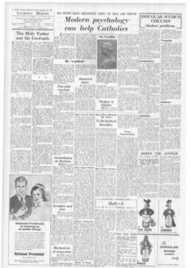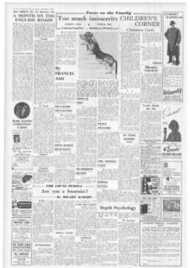Page 4, 21st November 1958
Page 4

Report an error
Noticed an error on this page?If you've noticed an error in this article please click here to report it.
Tags
Share
Related articles
Heraldry
Problems Of Designing Papal Arms
Archbishop Bruno Heim. The Swissborn Apostolic Delegate...
The Papal Coat Of Arms And Its Copyright
Arms Of The Popes
Ecclesiastical
Heraldry In a Few Words By Jotter
Papal Arms & Venice
ITHERE are many interesting features about the new Papal Arms which are reproduced on page one. The shield, without the fleur-de-lys and Lion of St. Mark, is that of the various Lombard families of Roncalli, including that of the Counts of Montorio. The fleur-de-lys were part of the coat of the Pope when in 1925 he was consecrated titular archbishop of Areopolis. It would seem, therefore, that they have nothing to do with his service as nuncio in France as has been suggested. The Lion of St. Mark was part of the arms of the Republic of Venice, but a red background and a golden lion with a sword, earth and water then represented the authdrity of the Holy Roman Empire and the nature of Venice. The words on the open book recall the fact that the devotion of Venice to St. Mark predates the transference of his body to Venice and goes back to the very ancient memories and traditions of the Evangelist's preaching in those parts. Seven Popes (Benedict Xl. Gregory Xll, Euenius IV, Paul 11, Alexander VIII, Clement XIII, Gregory XVI) were Venetians, but only two have been Patriarchs of Venice, St. Pius X and John XXIII, who both came from within the boundaries of the dominion of the ancient Republic.
More Papal Puzzles
A READER, Mr. Cormac Rigby of St, John's College, Oxford, has queried in our article " The Rock of Peter " the statement that Celestine V is the only Pope who has abdicated. This is certainly the general view, and I strongly recommend readers who can get hold of a copy to read the delightful life by " John Ayscough " (Mgr. Bickerstaff-Drew) called "San Celestino". Mr. Rigby suggests that Gregory XII abdicated in 1415. two years before the election of Martin V which ended the Cireat Schism. The reference books describe him as having resigned. But until the election of Martin V there was no other valid Pope, the " Urbanists ", who constitute the true line, being Urban VI, Boniface IX, Innocent VII, and Gregory XII on to the end of the schism with Martin V. But here come fresh problems because the Addis and Arnold "Catholic Dictionary " states that the Avignon claimants are "never styled antipopes" but " popes in their obedience'. This is a new one on me. It is true that the numbering of the Alexanders includes the " antipope" Alexander V, though the Clements and the Benediets disregarded the Avignon Clement VII and Benedict XIII. In calling himself John XXIII, the present Pope has followed the example of the latter.
Malachy Prophecies
THE striking way in which Pope John XXIII has apparently fulfilled the requirement of Si Malachy, who was archbishop of Armagh in the 12th century. has brought many letters asking about these famous prophecies about popes. There seems to be no doubt at all that these prophecies are 16th century forgeries, and their vagueness is such that almost any suitable pontiff could be shown to fulfil most of them. Still, they have certainly worked marvellously in
many cases, as in Leo Lux in Carlo corresponding to a comet in his coat of arms. That is why so much was hoped of Cardinal Agagianian whose arms show a Lamb of God standing on the sea with an anchor in it: Pastor et Nauta. There are six more to come. Flos Florum for the next Pope does not look very hopeful. After that comes De Afedietate Luna (whatever that means: halfmoon?). De Labore Solis, Gloria °lime, and the last Pope before the world's end, Petrus Romanus or Petrus Secundus.
Names of Popes
L ETTERS have also come about " the numbering of the Popes Johns, it being pointed out in one that "John XXIII" already appears on the list in Westminster Cathedral, and John XVI, as well as John XXIII, are listed as anti-popes in the "Catholic Directory". With John XX completely missing, this would make the present Holy Father John XXI. The name that has come nearest to John for popularity is Gregory, with Gregory XVI who was elected in 1831. The Piuses have advanced with great speed in modern times, Pius VI and VII closing the 18th century and entering the 19th. Pius VIll only reigned for two years (1829-1831), and within the last century we have had the four Pluses from Pius IX to Pius XII. The last pope to use his own name or choose a new one was Pope Lando, who only reigned for six months in the tenth century and about whom virtually nothing is known. Another papal curiosity is that the only papal name taken from the apostles and evangelists is that of John, though there have been five Paula.
Non-Catholic Readers
THE recent death of Rose Mac aulay, whom I knew, though only slightly, for many years, reminds me that the apostolate of the Catholic press need by no means be confined to our coreligionists. I remember years ago an Anglican friend jokingly remarking to me that if he had missed his CATHOLIC HERALD all he had to do was to visit the nearest Angklican vicarage and borrow a copyliThis vast exaggeration does however underline the fact that there must be a good many Anglican and other non-Catholic readers of this paper. Letters, in fact, show that this is so. Miss Macaulay was certainly a regular reader and many times sent us let ters for publication. My job involves me in reading the "Church Times", a paper which, however vexing, is always a week-end stimulant. I think readers introducing a paper like ours to intelligent and religiously interested nonCatholics would create even more regular readers. The effect would at least be that they would come to know us better.
Famous Acquapendente
TWO or three years ago I was A driving south from Siena with the idea of visiting Perugia and Assisi. Those who know that arid country will appreciate that on a blindingly hot day the mind works slowly and even though turnings are rare they still can easily he missed. Almost sure that we had driven half asleep past the vital turning, we asked an Italian who looked as though he had been dropped from another car that had ceased to go his way. He assured us that we were heading straight for Assisi, and this happened to he his way also, A charming, chatty man, we left ourselves in his hands. It seemed an astonishingly long way and at length we arrived on the outskirts of Acquapendente and all we knew about it was that one of Pius XII grandparents came from it. Our friend explained that this was his paese and that a certain road would shortly take us to Perugia. Of course, we soon realised that he had led us miles out of our way and miles into his. All this was vividly recalled to me this week when re-reading after many years "The Path to Rome" in the new Penguin edition. " In this way," wrote IRelloc, " we reached the famous town of Acquapendente. But why it should be called famous Is more than I can understand. It may he that in one of those narrow streets there is a picture or a church, or one of those things which so attract unbelieving men. To the pilgrim it is simply a group of houses. Into one of these I went, and, upon my soul, I have nothing to say of it except that they furnished me with food." With all of which I retrospectively heartily sympathise.
blog comments powered by Disqus









